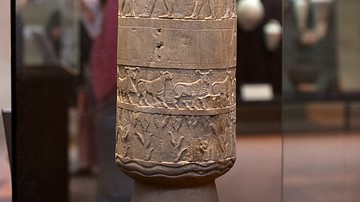Illustration
The votive or sacred Warka Vase is decorated with three horizontal registers and shows signs of repair in antiquity. The bottom register of the Warka Vase is composed of two horizontal parts. The lower portion depicts naturalistic components of life with a multitude of vegetation, including water and plants (date palm, barley, and wheat). On the upper portion of the lowest register, alternating rams and ewes march in a single queue depicted in profile.
The Vase of Warka, is one of the priceless objects in the Iraq Museum and represents one of the earliest examples of surviving narrative art. It was excavated (in fragments) by a German excavation team in a temple complex dedicated to the goddess Inanna at the city of Uruk (in southern Iraq) in 1933-1934 CE.
It is about 1 meter tall. From Warka (ancient Uruk), Iraq. Jemdet Nasr Period, 3000-2900 BCE. On display at the Sumerian Gallery in the Iraq Museum in Baghdad, Republic of Iraq.
About the Author
Cite This Work
APA Style
Amin, O. S. M. (2019, May 10). Warka Vase [Bottom Register]. World History Encyclopedia. Retrieved from https://www.worldhistory.org/image/10536/warka-vase-bottom-register/
Chicago Style
Amin, Osama Shukir Muhammed. "Warka Vase [Bottom Register]." World History Encyclopedia. Last modified May 10, 2019. https://www.worldhistory.org/image/10536/warka-vase-bottom-register/.
MLA Style
Amin, Osama Shukir Muhammed. "Warka Vase [Bottom Register]." World History Encyclopedia. World History Encyclopedia, 10 May 2019. Web. 12 Jan 2025.

![Warka Vase [Bottom Register]](/img/r/p/750x750/10536.jpg?v=1599153304)

![Offering to Inanna, Warka Vase [Top Register]](https://www.worldhistory.org/img/c/p/360x202/10591.jpg?v=1724658839-1724658887)
![Warka Vase [Middle Register]](https://www.worldhistory.org/img/c/p/360x202/10597.jpg?v=1599154203)
![Detail of Warka Vase [Top Register]](https://www.worldhistory.org/img/c/p/360x202/10595.jpg?v=1599154203)
![Offering Scene, Warka Vase [Top Register]](https://www.worldhistory.org/img/c/p/360x202/10594.jpg?v=1618594218)

